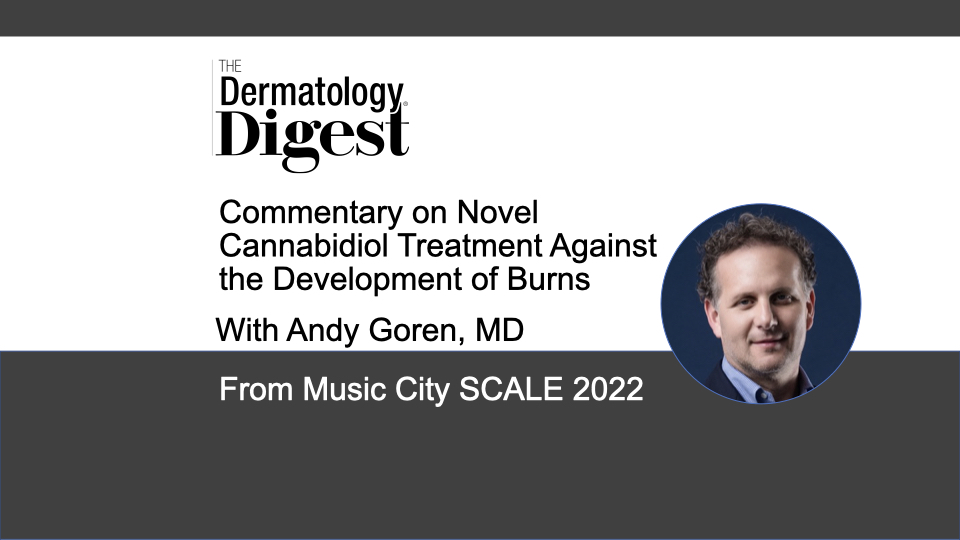Dr. Andy Goren discusses research that suggests cannabidiol plus aspartame has protective and possible reparative effects on first-degree burns.
Andy Goren, MD, is Professor of Dermatology (contratto), University of Rome G. Marconi, Rome, Italy, and President and Chief Medical Officer of Applied Biology, Irvine, California
“I primarily do research—a lot of alopecia research, but [I] … connected with a company [that] asked me to do a clinical study on a cannabidiol and aspartame combination for eczema. We published this paper1 and the results were really impressive,” said Andy Goren, MD, who presented “Novel Cannabidiol Treatment Against the Development of Burns” at the Symposium for Cosmetic Advances and Laser Education (SCALE) 2022.
From there he was asked to explore the effects of that same cannabidiol (CBD) and aspartame combination (JW-300, Jupiter Wellness) on first-degree burns.
“First-degree burns are obviously very common. And one of the most common ways of getting a first-degree burn is a UVB sunburn.”
Although CBD has become a popular additive to sunscreen products, its protective effects are generally unknown. Nor will testing sunscreens that include CBD reveal anything about the effects of CBD on UVB burns, said Dr. Goren.
“And so I thought, hey, why don’t we look at a model where it’s using UVB in vitro and demonstrate that there is some protective effect?”
Not only do first-degree UVB burns serve as a good model for studying first-degree burns in general, but they’re also easy to standardize with use of a UV lamp, said Dr. Goren.
Is It Protective?
“[First] we did an in vitro analysis. We wanted to see whether this formulation that this company has is able to provide protection from burns, or help cells actually survive those burns independent of the UVB absorption.”2
CBD is not absorbed in the UVB spectrum (ie, it’s not a chemical blocker), said Dr. Goren.
“If we [use] a molecule that interferes with UVB absorption, then obviously you’re not going to learn about if [CBD] helps burning or not.”
If it does have an effect on cell survival, then CBD may be a potential treatment for first-degree burns, said Dr. Goren.
“The fact that the CBD is not absorbed in the UVB spectrum means that if it does have some sort of effect on the cells, survival means that they’re actually helping as a potential treatment for first degree burns. So that was the hypothesis.”
Three concentrations of the CBD combination product (1 µM, 4 µM and 8 µM) were used to treat keratinocytes and melanocytes, said Dr. Goren.
“We started basically with the melanocytes and keratinocytes that we cultured and… we treated with this cannabidiol combination… and then we incubated those cells.”
Cell viability was evaluated using the MTT assay, said Dr. Goren.
Researchers found that both types of cells demonstrated a dose-dependent increase in cell viability at the two lower (1 µM and 4 µM) concentrations.
The 8 µM concentration offered survival effects in keratinocytes but reduced cell viability for melanocytes, said Dr. Goren.
“In melanocytes, there… was a maximum reach. When you reach that maximum, it seems to increase survival, but then too much reduced survival.”
Overall, the results suggest that the survival effect is biological separate from the physical barrier sunscreen ingredients provide, said Dr. Goren.
“So that was the important takeaway that we learned from the in vitro study.”
Based on these findings, CBD is, in fact, protective and could be a potential treatment for first-degree burns, said Dr. Goren.
Could It Be a Burn Treatment?
Taking the research one step further, findings were applied to an in vivo study, he said.3
“…we irradiated [patients] with UVB, with a certain amount that actually is going cause them [to] burn.”
In the clinical trial, 36 patients were randomized to receive either JW-300 (n = 18) or topical placebo (n = 18) to the treatment area after exposure to UVB irradiation. Burn was measured by erythema.
Erythema scores were significantly lower in the treatment vs placebo group (27% vs 61%, p=0.047). The average erythema score in the treatment group was 0.388 after radiation compared to 0.722 for placebo.
“What we’ve shown is, in the area where we applied [JW-300] after the burn… patients recovered much faster. So hence… we demonstrated that CBD has some therapeutic effects against first degree burns.”
References:
- Gao Y, Li Y, Tan Y, Liu W, Ouaddi S, McCoy J, Kovacevic M, Situm M, Stanimirovic A, Li M, Wambier C, Goren A, Zou Y. Novel cannabidiol aspartame combination treatment (JW-100) significantly reduces ISGA score in atopic dermatitis: Results from a randomized double-blinded placebo-controlled interventional study. J Cosmet Dermatol. 2022 Apr;21(4):1647-1650. doi: 10.1111/jocd.14263. Epub 2021 Jun 14. PMID: 34056830.
- Gohad P, McCoy J, Wambier C, Kovacevic M, Situm M, Stanimirovic A, Goren A. Novel cannabidiol sunscreen protects keratinocytes and melanocytes against ultraviolet B radiation. J Cosmet Dermatol. 2020 Sep 16. doi: 10.1111/jocd.13693. Epub ahead of print. PMID: 32964699.
- JW-300 Demonstrated Efficacy in the Treatment of Developing Burns (sunburn) in a Double-Blinded Placebo-Controlled Clinical Trial [Press Release]. May 4, 2022. Available at: https://onlinelibrary.wiley.com/doi/10.1111/jocd.13693. Accessed June 13, 2022.


